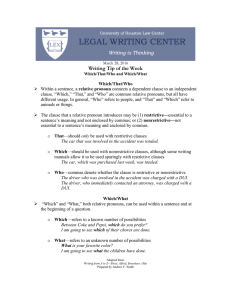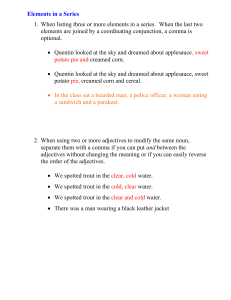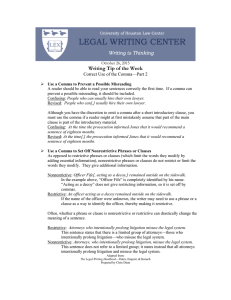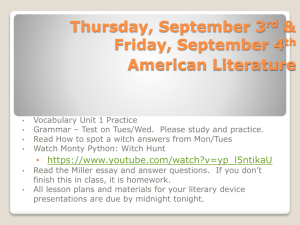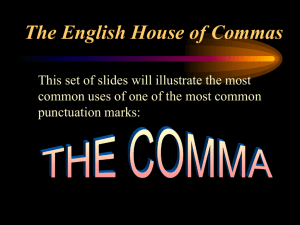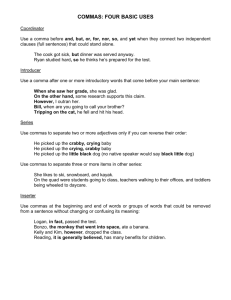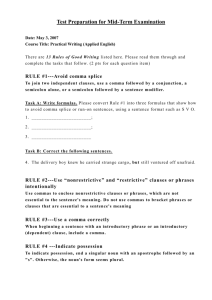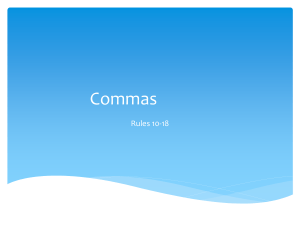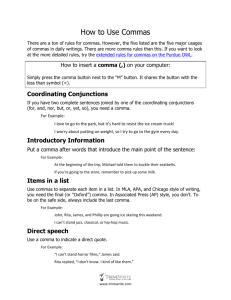Grammar Review
advertisement
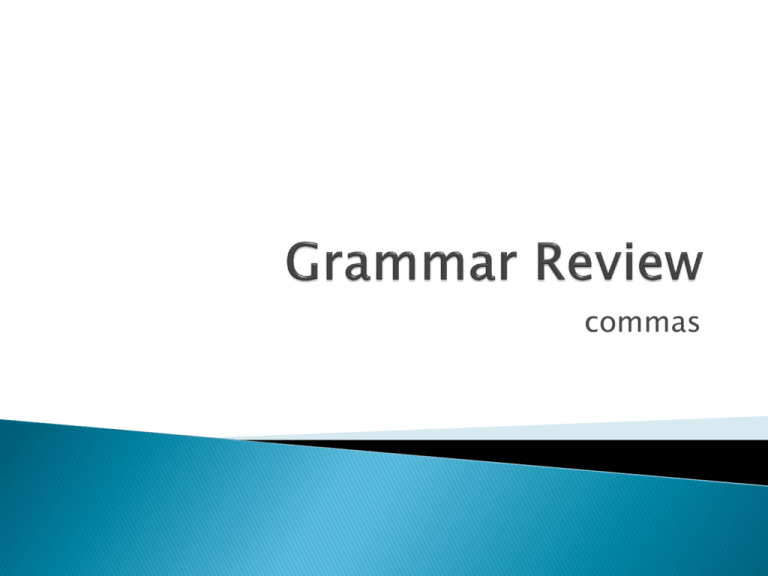
commas An introductory element can be ◦ a word, phrase or clause that tells ◦ When, where, how or why the main action of the sentence occurs Slowly, Stacy recognized the dangers of her situation. In Hawthorne’s novel, the imagery is symbolic. Sporting a new pair of running shoes, Logan prepared for the race. Exception: if the introductory element is followed by inverted word order (verb preceding subject), do not use a comma unless misreading may occur. Example: From directly behind my seat came huge clouds of smoke. Exception: If the introductory element is short, you may omit the comma. Remember FANBOYS: Coordinating conjunctions are for, and, nor, but, or, yet, so. Examples: The title may sound important, but the administrative clerk’s job was merely photocopying. The show started at last, and the crowd grew quiet. EXCEPTION: with very short clauses, writers sometimes omit the comma before and & or. USE NO COMMA if one of the clauses is NOT independent: The student wrote the essay and submitted it to Turnitin.com. The student wrote the essay, and he submitted it to Turnitin.com. Nonrestrictive elements can be clauses, phrases and words. They are nonrestrictive because they do not limit, or restrict, the meaning of the words they modify. How do you know it’s nonrestrictive? ◦ Mentally delete the element. ◦ Then decide whether the deletion changes the meaning or makes it unclear. ◦ If it does, then the element is restrictive and should not be set off with commas. ◦ An adjective clause that begins with that is ALWAYS restrictive and it is not set off with commas. ◦ An adjective clause beginning with which may be either restrictive or nonrestrictive. Restrictive: Drivers who have been convicted of drunk driving should lose their licenses. Nonrestrictive: The two drivers involved in the accident, who have been convicted of drunk driving, should lose their licenses. Restrictive: The cat that ate the mouse is a deadly predator. Nonrestrictive: The cat which belongs to the Nora family is a deadly predator. Adverb clauses begin with when, where, because, although or before. Do not set them off with commas unless they precede the independent clause or begin with although, even though, while or another conjunction expressing contrast. Nonrestrictive: The city renovated Welles Park, which soon became a popular gathering place. Contrast: The park soon became a popular gathering place, although some nearby residents complained about the noise. Restrictive: The claim that men like to play video games is not a myth. Prepositional phrases are usually restrictive but sometimes are not essential to the meaning of the sentence and are therefore set off with commas. Examples of nonrestrictive phrases: ◦ Stephanie, amazed, started at the strange vehicle. ◦ Many Baby Boomers, fearing that Social Security funds will run out, are saving for retirement through company investment plans. ◦ The bodyguards, in dark suits and ties, looked quite intimidating. Examples of nonrestrictive appositives: ◦ Mrs. Nora, a high school English teacher, enjoys reading novels. ◦ The cat, a purebred Siamese, attacked the bird. Examples of restrictive appositives: ◦ The editorial cartoonist Thomas Nash helped destroy the Tweed ring in New York City. ◦ Mozart’s opera The Marriage of Figaro was revolutionary. Exception: When items in a series contain commas of their own or other punctuation, separate them with semicolons rather than commas. Coordinate adjectives, those that relate equally to the noun they modify, should be separated by commas: ◦ The long, twisting, muddy road led to a shack in the woods. These are sometimes called interrupters. Examples: Some studies, incidentally, have shown that chocolate, of all things, helps prevent tooth decay. Roald Dahl’s stories, it turns out, were often inspired by his own childhood. Ceiling fans are, moreover, less expensive than air conditioners. Contrasting elements: On official business it was she, not my father, one would usually hear on the phone. Interjections: Holy cats, who wouldn’t want to win the lottery? Direct address: My friends, I ask you for your vote. Tag questions: The governor did not veto the crime bill, did she? Dates: Use a comma between the day of the week and the month, between the day of the month and the year, and between the year and the rest of the sentence, if any. Addresses and place-names: Use a comma after each part of an address or place name, including the state if no zip code is given. Do not use a comma before a zip code. Titles: Use commas to set off a title such as M.D., Ph.D., Esq. from the name preceding it. Numbers: In numbers of five digits or more, use a comma between each group of three digits, starting from the right. A commas following a quotation mark goes inside the closing quotation mark. ◦ “All I know about grammar,” said Joan Didion, “is its infinite power.” Do not use a comma after a question mark or an exclamation point. ◦ “What are you bringing to the party?” asked Jill. ◦ “You’re fired!” said Donald Trump. Do not use a comma to introduce a quotation with that. ◦ Ralph Waldo Emerson said that “imitation is suicide.” Do not use a comma with a quotation when the rest of the sentence includes more than the words used to introduce or identify the source of the quotation. ◦ People who say “no problem” instead of “you’re welcome” irritate me.
